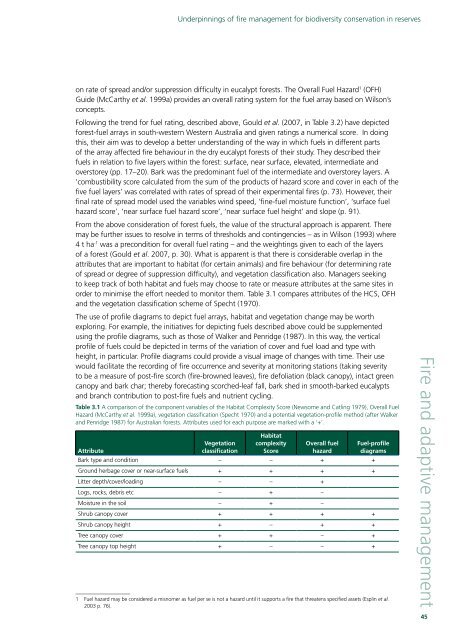Underpinnings of fire management for biodiversity conservation in ...
Underpinnings of fire management for biodiversity conservation in ...
Underpinnings of fire management for biodiversity conservation in ...
You also want an ePaper? Increase the reach of your titles
YUMPU automatically turns print PDFs into web optimized ePapers that Google loves.
<strong>Underp<strong>in</strong>n<strong>in</strong>gs</strong> <strong>of</strong> <strong>fire</strong> <strong>management</strong> <strong>for</strong> <strong>biodiversity</strong> <strong>conservation</strong> <strong>in</strong> reserves<br />
on rate <strong>of</strong> spread and/or suppression difficulty <strong>in</strong> eucalypt <strong>for</strong>ests. The Overall Fuel Hazard1 (OFH)<br />
Guide (McCarthy et al. 1999a) provides an overall rat<strong>in</strong>g system <strong>for</strong> the fuel array based on Wilson’s<br />
concepts.<br />
Follow<strong>in</strong>g the trend <strong>for</strong> fuel rat<strong>in</strong>g, described above, Gould et al. (2007, <strong>in</strong> Table 3.2) have depicted<br />
<strong>for</strong>est-fuel arrays <strong>in</strong> south-western Western Australia and given rat<strong>in</strong>gs a numerical score. In do<strong>in</strong>g<br />
this, their aim was to develop a better understand<strong>in</strong>g <strong>of</strong> the way <strong>in</strong> which fuels <strong>in</strong> different parts<br />
<strong>of</strong> the array affected <strong>fire</strong> behaviour <strong>in</strong> the dry eucalypt <strong>for</strong>ests <strong>of</strong> their study. They described their<br />
fuels <strong>in</strong> relation to five layers with<strong>in</strong> the <strong>for</strong>est: surface, near surface, elevated, <strong>in</strong>termediate and<br />
overstorey (pp. 17–20). Bark was the predom<strong>in</strong>ant fuel <strong>of</strong> the <strong>in</strong>termediate and overstorey layers. A<br />
‘combustibility score calculated from the sum <strong>of</strong> the products <strong>of</strong> hazard score and cover <strong>in</strong> each <strong>of</strong> the<br />
five fuel layers’ was correlated with rates <strong>of</strong> spread <strong>of</strong> their experimental <strong>fire</strong>s (p. 73). However, their<br />
f<strong>in</strong>al rate <strong>of</strong> spread model used the variables w<strong>in</strong>d speed, ‘f<strong>in</strong>e-fuel moisture function’, ‘surface fuel<br />
hazard score’, ‘near surface fuel hazard score’, ‘near surface fuel height’ and slope (p. 91).<br />
From the above consideration <strong>of</strong> <strong>for</strong>est fuels, the value <strong>of</strong> the structural approach is apparent. There<br />
may be further issues to resolve <strong>in</strong> terms <strong>of</strong> thresholds and cont<strong>in</strong>gencies – as <strong>in</strong> Wilson (1993) where<br />
4 t ha-1 was a precondition <strong>for</strong> overall fuel rat<strong>in</strong>g – and the weight<strong>in</strong>gs given to each <strong>of</strong> the layers<br />
<strong>of</strong> a <strong>for</strong>est (Gould et al. 2007, p. 30). What is apparent is that there is considerable overlap <strong>in</strong> the<br />
attributes that are important to habitat (<strong>for</strong> certa<strong>in</strong> animals) and <strong>fire</strong> behaviour (<strong>for</strong> determ<strong>in</strong><strong>in</strong>g rate<br />
<strong>of</strong> spread or degree <strong>of</strong> suppression difficulty), and vegetation classification also. Managers seek<strong>in</strong>g<br />
to keep track <strong>of</strong> both habitat and fuels may choose to rate or measure attributes at the same sites <strong>in</strong><br />
order to m<strong>in</strong>imise the ef<strong>for</strong>t needed to monitor them. Table 3.1 compares attributes <strong>of</strong> the HCS, OFH<br />
and the vegetation classification scheme <strong>of</strong> Specht (1970).<br />
The use <strong>of</strong> pr<strong>of</strong>ile diagrams to depict fuel arrays, habitat and vegetation change may be worth<br />
explor<strong>in</strong>g. For example, the <strong>in</strong>itiatives <strong>for</strong> depict<strong>in</strong>g fuels described above could be supplemented<br />
us<strong>in</strong>g the pr<strong>of</strong>ile diagrams, such as those <strong>of</strong> Walker and Penridge (1987). In this way, the vertical<br />
pr<strong>of</strong>ile <strong>of</strong> fuels could be depicted <strong>in</strong> terms <strong>of</strong> the variation <strong>of</strong> cover and fuel load and type with<br />
height, <strong>in</strong> particular. Pr<strong>of</strong>ile diagrams could provide a visual image <strong>of</strong> changes with time. Their use<br />
would facilitate the record<strong>in</strong>g <strong>of</strong> <strong>fire</strong> occurrence and severity at monitor<strong>in</strong>g stations (tak<strong>in</strong>g severity<br />
to be a measure <strong>of</strong> post-<strong>fire</strong> scorch (<strong>fire</strong>-browned leaves), <strong>fire</strong> defoliation (black canopy), <strong>in</strong>tact green<br />
canopy and bark char; thereby <strong>for</strong>ecast<strong>in</strong>g scorched-leaf fall, bark shed <strong>in</strong> smooth-barked eucalypts<br />
and branch contribution to post-<strong>fire</strong> fuels and nutrient cycl<strong>in</strong>g.<br />
Table 3.1 A comparison <strong>of</strong> the component variables <strong>of</strong> the Habitat Complexity Score (Newsome and Catl<strong>in</strong>g 1979), Overall Fuel<br />
Hazard (McCarthy et al. 1999a), vegetation classification (Specht 1970) and a potential vegetation-pr<strong>of</strong>ile method (after Walker<br />
and Penridge 1987) <strong>for</strong> Australian <strong>for</strong>ests. Attributes used <strong>for</strong> each purpose are marked with a ‘+’.<br />
Attribute<br />
Vegetation<br />
classification<br />
Habitat<br />
complexity<br />
Score<br />
Overall fuel<br />
hazard<br />
Fuel-pr<strong>of</strong>ile<br />
diagrams<br />
Bark type and condition – – + +<br />
Ground herbage cover or near-surface fuels + + + +<br />
Litter depth/cover/load<strong>in</strong>g – – +<br />
Logs, rocks, debris etc – + –<br />
Moisture <strong>in</strong> the soil – + –<br />
Shrub canopy cover + + + +<br />
Shrub canopy height + – + +<br />
Tree canopy cover + + – +<br />
Tree canopy top height + – – +<br />
1 Fuel hazard may be considered a misnomer as fuel per se is not a hazard until it supports a <strong>fire</strong> that threatens specified assets (Espl<strong>in</strong> et al.<br />
2003 p. 76).<br />
Fire and adaptive <strong>management</strong> 45





![Metcalfe State Forest Fauna Species List [PDF File - 16.9 KB]](https://img.yumpu.com/22024301/1/184x260/metcalfe-state-forest-fauna-species-list-pdf-file-169-kb.jpg?quality=85)






![PPE Price List for Wildlife Volunteers [PDF File - 20.3 KB]](https://img.yumpu.com/15321634/1/190x135/ppe-price-list-for-wildlife-volunteers-pdf-file-203-kb.jpg?quality=85)




